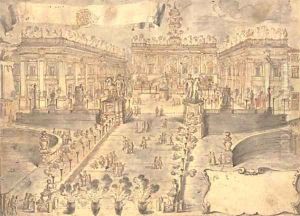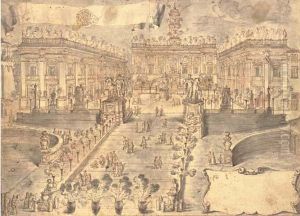Pompeo Aldrovandini Paintings
Pompeo Aldrovandini was an Italian painter of the Baroque period, born in 1677 in Bologna, Italy. He was part of a family of painters, with his father, Mauro Aldrovandini, and his brother, Giuseppe Maria Aldrovandini, also being accomplished artists of their time. Pompeo's work is often characterized by its architectural perspective and the use of trompe-l'œil, a technique that creates an optical illusion of three-dimensionality.
Pompeo Aldrovandini received his initial training in art from his father and continued his studies under the guidance of prominent artists such as Angelo Michele Colonna and Ferdinando Galli-Bibiena. Under the influence of these masters, Aldrovandini honed his skills in painting, particularly in the use of quadratura, a type of illusionistic ceiling painting that integrates architectural features with painted scenes.
During his career, Aldrovandini worked on numerous projects across Italy, contributing to the decoration of palaces, churches, and public buildings. His works can be found in various cities, including Bologna, Modena, and Genoa. Aldrovandini's style evolved throughout his life, reflecting the changing tastes and artistic trends of the period. He became known for his ability to blend realistic architectural elements with fantastical and imaginative scenes, impressing viewers with his skillful manipulation of perspective.
Aldrovandini's contributions to the art world were significant, and his works are seen as embodying the spirit of the Baroque era with their dynamism, dramatic use of light and shadow, and ornate detailing. Despite his achievements, Aldrovandini is not as widely recognized as some of his contemporaries, yet he remains a respected figure among those familiar with Baroque art.
Pompeo Aldrovandini passed away in 1735. Although his name might not be at the forefront of Baroque painters, his legacy lives on through the beautiful frescoes and paintings that adorn the walls and ceilings of Italian heritage sites. His work continues to be studied and admired by art historians and enthusiasts who appreciate the intricacy and technical prowess of his quadratura paintings.

